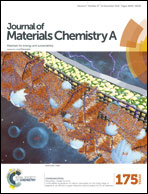AgBr tetradecahedrons with co-exposed {100} and {111} facets: simple fabrication and enhancing spatial charge separation using facet heterojunctions†
Abstract
The solar energy conversion efficiency of semiconductor materials is closely related to the separation rate of photogenerated charge carriers. Recently, “facet heterojunctions” have attracted much attention because of their outstanding capability for separating the photogenerated charge carriers. In this research, silver bromide (AgBr) crystals with different exposed facets were synthesized using a double-jet precipitation method using the inherent bromide (Br−) ions as the structure directing agent. The morphology and exposed facets of the AgBr crystals were conveniently tailored by adjusting the concentration of Br− ions, i.e., cubes with {100} facets, tetradecahedrons with both {100} and {111} facets, and octahedrons with {111} facets were synthesized when the concentrations of Br− ions were 10−3.0, 10−2.5, and 10−2.0 M, respectively. Br− ions can clearly decrease the surface energies of the (100) and (111) surfaces, by which the growth rate of AgBr nuclei along the [100] and [111] directions can be tuned by adjusting the concentration of Br− ions, leading to the formation of AgBr crystals with different exposed facets. The transient photocurrent, electrochemical impedance, and photoluminescence spectrum measurements indicated that the tetradecahedral AgBr crystals show higher electron–hole separation rate than the cubic and octahedral ones. Mott–Schottky and photo-oxidation deposition experiments revealed that the photogenerated electrons and holes are transferred to AgBr {100} and {111} facets, respectively. The benefit from the effective spatial isolation of photogenerated electrons and holes was that tetradecahedral AgBr crystals with co-exposed {100} and {111} facets showed enhanced photocatalytic activity for the degradation of methyl orange and sulfadiazine.


 Please wait while we load your content...
Please wait while we load your content...